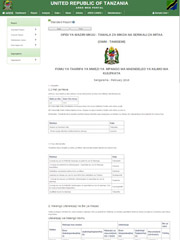Project for Capacity Development on Data Collection, Analysis and Data-based Reporting under ASDP (ARDS)
| Type | Project | Area | Period | Tanzania Organization |
Cost (Mill. Yen) |
|---|---|---|---|---|---|
| Technical Cooperation Project | Project for Capacity Development on Data Collection, Analysis and Data-based Reporting under ASDP (ARDS) | Whole country | Nov. 2015 - Oct. 2020 | Agricultural Sector Lead Ministries (ASLMs), ASDP M&E Thematic Working Group | 530 |
In Tanzania, national development and poverty reduction had been guided by the three Poverty Reduction Strategy documents since 2000. As for the contribution of the agricultural sector towards the implementation of that strategy, the Agricultural Sector Development Strategy (ASDS) was formulated in 2001 and the Agricultural Sector Development Programme (ASDP) was formulated in July 2006 to implement that strategy. The ASDP has adopted a sector wide approach with a basket fund supported by the Government of Tanzania (GoT) and Development Partners (DPs).
However, all these programs and strategies needed reliable agricultural related data as evidence references in planning and implementation of the programs. In addition, measurement data can help farmers better manage their operations, the more information they have the more they can make decisions that are tailored to their farms' specific needs.

In recent years, evidence-based policy making has become more and more mainstreamed in the whole world. The agricultural sector, which is one of the mainstays of the Tanzanian economy, is no exception in this trend. However, data collection and analysis for the agriculture sector has been a major challenge in Tanzania. This is partly because the reporting system has not functioned sufficiently well in collecting reliable data on a regular basis, hence the central government had difficulties in assessing the actual situation of the sector, especially when it wanted to refer to disaggregated data. Faced with this situation, the Government had to rely on data collected and reported by extension officers in the fields through each level of local governments (ward-district-region). Such data were consequently not standardized.
Therefore, in order to track and assess the performance of ASDP and provide reliable data, the Monitoring & Evaluation Thematic Working Group (M&E TWG) was established in December 2006 with the officers of the Agriculture Sector Lead Ministries (ASLMs). The Agricultural Routine Data System (ARDS) had been a primary source of agricultural data and information with the function that data are collected and sent monthly from grass root level (village and ward level) to the district level, and then to ASLMs through regions. Hence improvement of ARDS was urgently anticipated to ensure proper monitoring of ASDP progress and effectiveness.
With such a backdrop, the GoT in collaboration with JICA formulated a Project for Capacity Development for the ASDP M&E System, which had been implemented in several phases from 2008 to 2020. The project targeted all the districts on Tanzania Mainland and was implemented together with the members of the M&E TWG on DADP Planning and Implementation, which consists of officials from the ASLMs.
Through the activities in the pilot Local Government Authorities (LGAs) (Morogoro and Dodoma regions), various improvements of ARDS that include introduction of (i) VAEO/WAEO Format, (ii) Format for Integrated Data Collection, (iii) a software called LGMD2, (iv) training guides and the related human resource development were accomplished.
In a subsequent phase of the Project, those achievements were rolled out nationwide to all the LGAs, and the data collection software was improved into ARDS-LGMD2 that is a web-based system for data input as well as data utilization.
Currently, after the last phase of the Projects: "Project for Capacity Development on Data Collection, Analysis and Data-based Reporting under ASDP", ARDS is officially recognized as a government formal data collection system for the agricultural sector. ARDS is now consisted of the following components:
- VAEO/WAEO Format: These are three standardized formats (Monthly, Quarterly, and Annual) for data collection at village and ward levels.
- District Integrated Report Format: These are two standardized report formats (Quarterly and Annual), which are generated by assembling the data of the VAEO/WAEO format and the data collected at the district level.
- ARDS Web Portal: This is a web-based computer software / application with which users can enter, transmit, analyze data, and prepare reports based on the data. It is a refined system of the previous ARDS-LGMD2.
Tremendous achievements have been made through this project, which include:
- Enhancement of data collection: Proportion of wards which report data of their areas through the ARDS Web Portal has reached nearly 100%. This means that almost all wards now report their agricultural data to the central government regularly, a significant progress compared to around 10% in 2015.
- Improvement of data quality: Capacity building for extension officers has been enhanced, and introduction of checklists and warning function of the ARDS Web Portal has helped in eliminating blank data and outliers.
- Promotion of data utilization: Now ARDS is recognized by a broad range of stakeholders, and is utilized as a chief data resource in the "Agriculture Basic Data Booklet" compiled by the Ministry of Agriculture and other reports prepared by the local and central governments. Furthermore, it is expected that the ARDS data will be used as one of the primary sources for the monitoring and evaluation of "Agricultural Sector Development Program Phase 2" (ASDP2), the top program for agriculture sector in Tanzania.
- Incorporation of ARDS in the education curriculum of Ministry of Agriculture Training Institutes (MATIs).





scroll